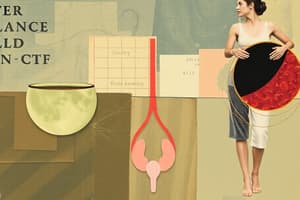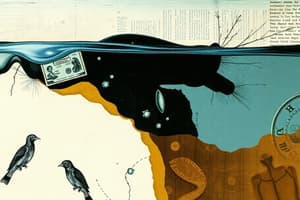Podcast
Questions and Answers
Which of the following is NOT a mechanism that regulates thirst?
Which of the following is NOT a mechanism that regulates thirst?
- Increased urine output (correct)
- Hyperosmolarity
- Hypovolemia
- Hypotension
In which condition is hypotonic fluid primarily lost?
In which condition is hypotonic fluid primarily lost?
- Diarrhea
- Diabetes insipidus (correct)
- Vomiting
- Excessive sweating (correct)
What is the total daily water intake for an average individual as indicated?
What is the total daily water intake for an average individual as indicated?
- 1.3 L
- 2.0 L
- 3.0 L
- 2.5 L (correct)
Which physiological condition leads to decreased urine volume?
Which physiological condition leads to decreased urine volume?
Which of the following correctly describes the relationship between water intake and water loss?
Which of the following correctly describes the relationship between water intake and water loss?
What effect does hypervolemia have on the thirst center?
What effect does hypervolemia have on the thirst center?
What is the daily water loss through sweating and insensible loss combined?
What is the daily water loss through sweating and insensible loss combined?
Which condition primarily results in loss of isotonic fluid?
Which condition primarily results in loss of isotonic fluid?
Which of the following would likely inhibit the thirst response?
Which of the following would likely inhibit the thirst response?
What daily water loss occurs through stool?
What daily water loss occurs through stool?
What hormone inhibits the effect of angiotensin II on thirst?
What hormone inhibits the effect of angiotensin II on thirst?
Which condition is characterized by excessive thirst due to a deficiency of ADH?
Which condition is characterized by excessive thirst due to a deficiency of ADH?
What effect does hypertension have on thirst?
What effect does hypertension have on thirst?
Which of the following accurately describes dehydration?
Which of the following accurately describes dehydration?
What is the primary function of anti-diuretic hormone (ADH)?
What is the primary function of anti-diuretic hormone (ADH)?
How does excessive secretion of ADH affect the body?
How does excessive secretion of ADH affect the body?
What type of dehydration is characterized by loss of both water and sodium?
What type of dehydration is characterized by loss of both water and sodium?
What is the primary action of aldosterone in the kidneys?
What is the primary action of aldosterone in the kidneys?
Which mechanism results in the inhibition of thirst during baroreceptor stimulation?
Which mechanism results in the inhibition of thirst during baroreceptor stimulation?
What condition can result from diuretic therapy affecting urine production?
What condition can result from diuretic therapy affecting urine production?
Flashcards
Water Balance
Water Balance
The state where the intake of water equals the loss of water.
Water Intake
Water Intake
Water consumed through drinking, eating solid foods, and metabolic processes.
Water Loss
Water Loss
Water lost through urine, stool, sweating, and insensible loss (like breathing).
Diarrhea
Diarrhea
Signup and view all the flashcards
Diabetes Insipidus
Diabetes Insipidus
Signup and view all the flashcards
Heat Exhaustion
Heat Exhaustion
Signup and view all the flashcards
Hyperventilation
Hyperventilation
Signup and view all the flashcards
Excessive IV Fluids
Excessive IV Fluids
Signup and view all the flashcards
Control of Thirst
Control of Thirst
Signup and view all the flashcards
Excessive Drinking
Excessive Drinking
Signup and view all the flashcards
What are baroreceptors and where are they located?
What are baroreceptors and where are they located?
Signup and view all the flashcards
What is Angiotensin II and its role in thirst?
What is Angiotensin II and its role in thirst?
Signup and view all the flashcards
What is Atrial Natriuretic Peptide (ANP) and how does it affect thirst?
What is Atrial Natriuretic Peptide (ANP) and how does it affect thirst?
Signup and view all the flashcards
What does Anti-diuretic hormone (ADH) do?
What does Anti-diuretic hormone (ADH) do?
Signup and view all the flashcards
What is Diabetes Insipidus (DI) and what causes it?
What is Diabetes Insipidus (DI) and what causes it?
Signup and view all the flashcards
What is Syndrome of Inappropriate ADH secretion (SIADH)?
What is Syndrome of Inappropriate ADH secretion (SIADH)?
Signup and view all the flashcards
What is dehydration and how is it classified?
What is dehydration and how is it classified?
Signup and view all the flashcards
What is Isotonic Dehydration?
What is Isotonic Dehydration?
Signup and view all the flashcards
What is Hypotonic dehydration?
What is Hypotonic dehydration?
Signup and view all the flashcards
What is Hypertonic dehydration?
What is Hypertonic dehydration?
Signup and view all the flashcards
Study Notes
Water Balance
- Water balance is maintained when water intake equals water loss.
- Daily water intake comes from drinking, food and metabolism (1.3L, 0.9L, and 0.3L respectively).
- Daily water loss comes from urine, stool, and sweating/insensible loss (1.4L, 0.2L, and 0.9L respectively).
Objectives
- Explain the mechanism of water balance.
- Relate water balance to common conditions like diarrhea, excessive sweating, burns, and diabetes insipidus.
Physiological Abnormalities of Water Balance
- Exercise: Increased water loss (sweating, hyperventilation) balanced by decreased urine volume and increased intake.
- Fasting: Decreased water intake balanced by decreased urine volume and increased intake.
- High temperature: Increased water loss balanced by decreased urine volume and increased intake.
Pathological Abnormalities of Water Balance
- Vomiting: Loss of isotonic fluid.
- Diarrhea: Loss of isotonic fluid.
- Diabetes insipidus: Loss of hypotonic fluid.
- Burn: Loss of hypotonic fluid.
- Heat exhaustion/excessive sweating: Loss of hypotonic fluid.
- Hyperventilation: Loss of hypotonic fluid.
- Excessive IV fluid: Excess isotonic fluid.
- Excessive drinking (Psycogenic): Excess hypotonic fluid.
Control of Water Intake
- Thirst center: Located in the hypothalamus.
- Stimuli for thirst: Hyperosmolarity, hypovolemia, hypotension, angiotensin II.
- Inhibitors of thirst: Opposite factors + ANP.
- Osmoreceptors: Located in the hypothalamus and respond to hyperosmolarity in the ECF (extracellular fluid), causing shrinking of the dendrites.
Control of Water Loss
- Involves: Kidneys and hormones (e.g., ADH).
- Kidneys: Reabsorb >99% of filtered water in glomeruli.
- About 7–13% reabsorption by ADH action.
Antidiuretic Hormone (ADH)
- Deficiency of ADH: Increases urine volume (up to 23L/day), causing excessive thirst = diabetes insipidus (DI).
- Excessive ADH secretion: Reduces urine volume, leads to hypertension and edema due to water retention = Syndrome of Inappropriate ADH Secretion (SIADH).
Dehydration
- Water +/− salt depletion
- Types: Isotonic, hypotonic, hypertonic
- Isotonic: caused by diarrhea or vomiting, no change in ECF and ICF osmolarity, no change in ICF and ECF volume.
- Hypotonic: caused by adrenal insufficiency/low aldosterone, decreased ECF osmolarity, increased ICF volume, decreased ICF osmolarity.
- Hypertonic: caused by Diabetes, sweating or diuretics, increased ECF osmolarity, decreased ICF volume, increased ICF osmolarity.
General Symptoms & Signs of Dehydration
- Thirst
- Dry mouth
- Rapid heartbeat
- Headache
- Dry skin
- Decreased urination
Treatment of Dehydration
- Depends on the type.
- Treatment of the cause.
- Intravenous (IV) fluids.
- Oral Rehydration Salts (ORS).
Effects of IV Solutions on Body Fluid Compartments
- Isotonic: No change in ECF or ICF osmolarity or volume.
- Hypotonic: Increased ECF volume, decreased ECF osmolarity, increased ICF volume and decreased ICF osmolarity.
- Hypertonic: Increased ECF osmolarity, decreased ICF volume, decreased ICF osmolarity.
Studying That Suits You
Use AI to generate personalized quizzes and flashcards to suit your learning preferences.



